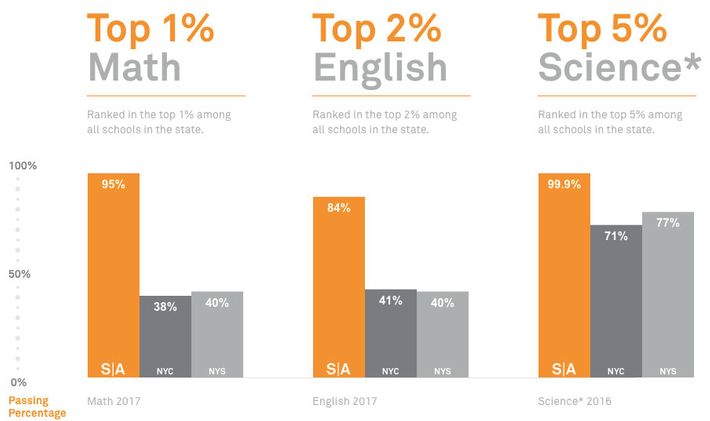
Of all the injustices in contemporary American society, perhaps the most grotesque is the system that ties education to neighborhoods that are segregated by race and class. One of the things a young couple buys along with a home is access to its school district, the value of which is incorporated into the sale price. It is universally understood that enjoying high-quality public schools is a perk of affluence, and being consigned to bad schools is one of the penalties for being poor.
It is strange that this brutal system is largely met with passive acceptance. It is even stranger that, to the extent the system is the object of public controversy, criticism is generally aimed at one of the sources of amelioration for its victims: charter schools. (My wife is an education-policy analyst who believes in charters enough to have gone to work for one.) Charter schools largely serve children whose only other option is a bad neighborhood school. Somehow this fact has become a central indictment against them.
That is the odd premise of a widely circulated Associated Press analysis from last week. The headline, “US charter schools put growing numbers in racial isolation,” captures the article’s frame, even though its data does not remotely bear out this sensational charge. The article notes, “[C]harters are vastly over-represented among schools where minorities study in the most extreme racial isolation. As of school year 2014-2015, more than 1,000 of the nation’s 6,747 charter schools had minority enrollment of at least 99 percent, and the number has been rising steadily.”
But that is not evidence that charters cause racial isolation. The deep cause of segregation is residential living patterns driven by decades of racist housing policy. Neighborhood schools reflect those patterns of racial segregation. Indeed, the neighborhood-based school system makes it almost impossible for schools not to reflect segregated housing patterns. Charters disproportionately serve children in heavily minority neighborhoods because those are the children who can’t get a decent education from their neighborhood schools. The schools that those children would otherwise be attending are also segregated.
And while integrated schools would be better, integrating schools is hard, since middle-class families have the ability to relocate to the suburbs or withdraw into private schools. Nobody has formulated a plan to achieve large-scale school integration that stands any practical chance of success during the lifetime of today’s students. That doesn’t mean working for desegregation is not a noble and necessary cause. It means it cannot be the only mechanism to allay the appalling lack of educational opportunity given to children in segregated neighborhoods.
Some people, especially in the charter-school world, have figured out ways to give urban students better educations. Charters are open free of charge to all students, and cannot select whom to admit — unlike private school vouchers, a policy with which they are often confused. (If desire for enrollment exceeds available slots, charters must use a lottery.) The quality of charters varies significantly, depending on the level of their management. Rigorous studies comparing students who won the lottery to attend a charter with those who lost — a design that eliminates the possibility charters are only succeeding by skimming out better students — find that charters produce more academic achievement for urban children.
The most effective charter schools produce truly spectacular gains. Success Academy, run by Eva Moskowitz, has done something no education-policy analyst considered remotely possible: Its schools have closed the achievement gap. The education field has spent decades working to close the chasm in performance between black and white students. Progress that had been measured inch by inch over the decades has been registered by Success Academy in miles. The overwhelmingly poor and minority students outscore schools in wealthy suburbs filled with parents who attended college.

Students with disabilities and English-language learners at Success Academy outperform those at traditional schools by even larger margins. An army of researchers — some skeptical at the outsize scale of its achievement, and some determined to vindicate the ideology of charter critics — has tried to poke holes in its results, to little avail. Skeptical attention has dominated coverage, especially in recent years, with the perverse result of overshadowing one of the great achievements in the history of American social policy.
++
What urban charters in general, and Success Academy in particular, have figured out is that the achievement gap is not, as some conservatives have speculated, genetic. Nor is it some ethereal “culture” that defies institutional design. It is the product of a confluence of policy and environmental factors that can be identified and remedied. The achievement gap results from a gap in health, nutrition, parental involvement, community expectations, an orderly school environment, exposure to vocabulary, and access to books, among other things. Urban charter schools have systematically identified the missing sources of support and supplied them.
One important source of the opportunity gap is tenure rules that make it difficult or impossible to replace ineffective teachers. Studies have found that the quality of a child’s teacher matters enormously to their future prospects, that tenure protections and last-in, first-out contracts negotiated by unions make firing ineffective teachers extremely difficult, and that the poorest students are often most likely to be stuck with grossly ineffective teachers. What’s more, poor students suffer disproportionate harm from having ineffective teachers, since their families lack the resources — hiring tutors, or relying on their parents’ education — to overcome the shortfall in learning. All charters have the ability to remove ineffective teachers — a key tool that traditional public schools with rigid tenure protections lack, and which largely accounts for the left’s implacable opposition.
Success Academy also incorporates other methods found at some of the highest-performing charters, like KIPP, as well as unique innovations. (My wife does not work for either Success or KIPP, for what it’s worth.) The schools employ high standards and an almost fanatical devotion to maximizing their learning time, all of which allow children raised in homes with fewer books and words than privileged affluent children to catch up and overtake them.
The Atlantic’s Elizabeth Green and The New Yorker’s Rebecca Mead both recently profiled Moskowitz and attempted to figure out how Success Academy has produced such extraordinary outcomes. Both writers approach their subject with skepticism. Green gave up hers, concluding, despite her ideological misgivings, that Success Academy has created “the most promising model we have for public education.”
Mead, on the other hand, clings to her skepticism. While she concedes that Success Academy genuinely produces high academic achievement, the underlying theme of her story is that Success Academy’s pedagogy is too rigid, “a bureaucratic mode of learning.”
Mead begins her story by recounting the wildly precious education of John Stuart Mill, whose father pushed him relentlessly, who had learned Greek by the age of 3 and studied Herodotus before the age of 7; Moskowitz cites Mill. Mead, cleverly, points out that Mill suffered a nervous breakdown as a young adult — illustrating her thesis that Success Academy’s scholastic achievements must come at a social cost.
It’s a coda no writer could resist. But maybe the comparison is ill-wrought. Mill’s academic progress was truly freakish. Is it freakish for poor urban students to match the learning of their privileged counterparts? Or is equality a natural outcome we might expect when well-designed policy unlocks the latent talents of students who have been ill-served for decades?
Mead hypothesizes that the rigidity and heavy pressure of its methods nevertheless fail them. Her story provides rich reportorial detail — it is a very worthwhile read — but she produces little hard evidence to substantiate her suspicions. The only statistic she produces to gainsay Success Academy’s work is highly misleading. “Although charter students are admitted to college at higher rates than students from comparable public schools, their graduation rates are dispiritingly low,” she writes, “seventy per cent of charter-school students who enroll in college fail to complete their degrees within six years.”
Oddly, Mead does not include the comparable graduation rate for students from traditional public schools who enroll in college. If her thesis was correct, and charters are doing an especially bad job of preparing students for college, traditional-school students would graduate at a higher rate. But Mead does not provide any comparison statistic. According to the National Alliance for Public Charter Schools, however, 25 percent of students from traditional public schools serving primarily low-income families enrolled in college graduate within six years, while 27 percent of charter-school students do so — a fact that would seem to deeply undercut Mead’s thesis.
I can’t be certain the figures from an interested party are correct. But I do suspect that, if it were true that charter students graduated from college at a lower rate than other poor children, that fact would have found its way into her story, rather than comparing apples to … nothing.
Of course, 30 percent is still low and an important social problem. Even poor kids who get into college have a hard time completing it, for financial reasons among others. Blaming charter schools that have performed social miracles getting poor kids into good colleges because they could not control what happens on campus seems hardly more fair than blaming them for decades of residential segregation.
Segregation has, amazingly, become the primary talking point for charter critics. It is an argument for leaving urban children in poor-performing segregated neighborhood public schools instead of high-performing segregated public charter schools. No longer able to make the case that charters don’t work, their critics have fallen back to the charge that they can’t solve every problem in American society.
As amazing as the best charter schools may be, they cannot solve every problem in American society. But must we wait until all those problems have disappeared to give poor urban children a chance?






























